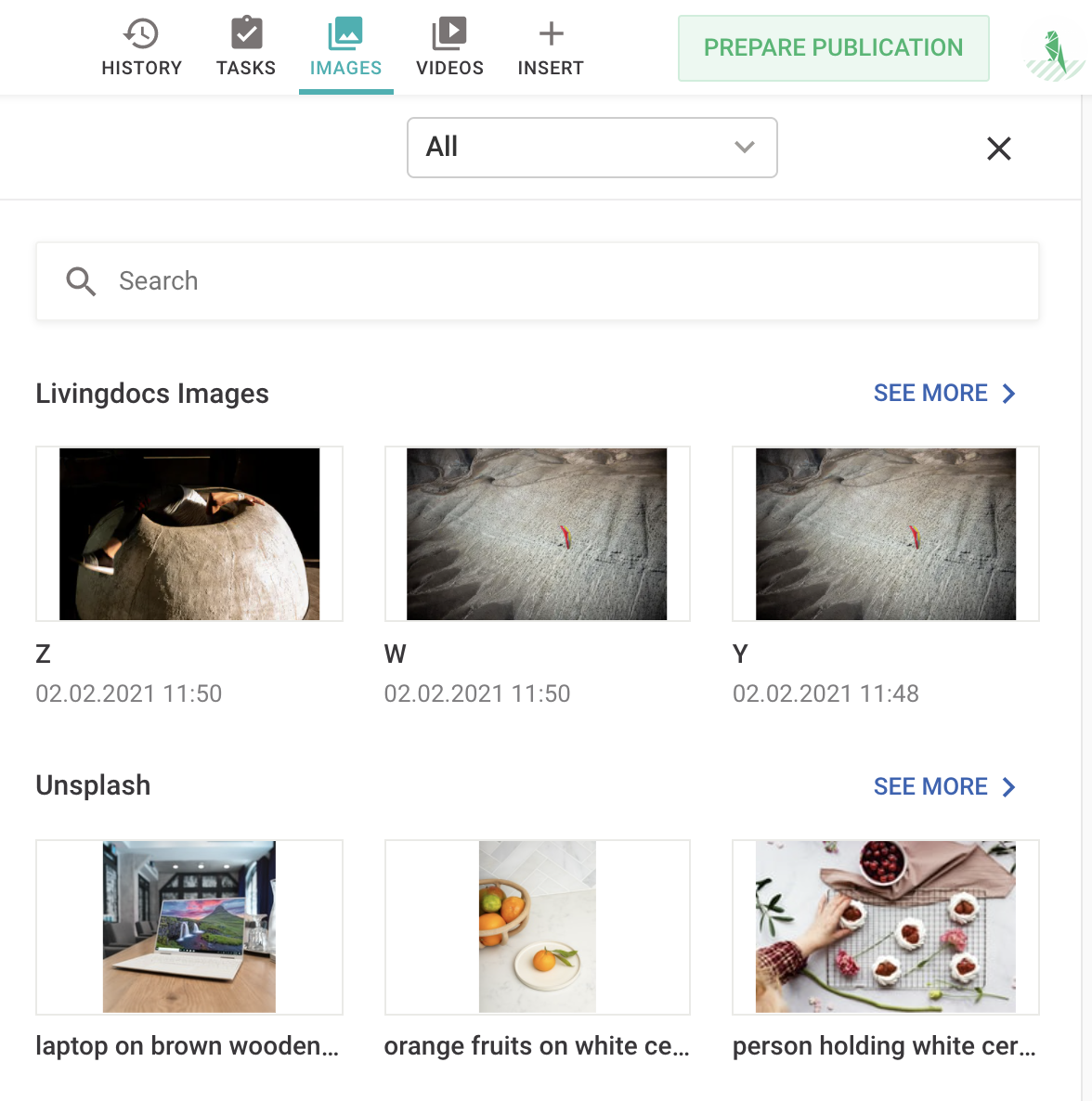With Media Sources you can integrate asset research/import into Livingdocs. Instead of having to log in to another platform like Unsplash and then drag + drop images into Livingdocs, you can have Unsplash assets search results available directly in Livingdocs.
If you have integrated a Media Source properly, the Livingdocs editor also shows the search results of the Media Source which can be added to the document like any other asset via drag+drop.

Example
To integrate a Media Source into Livingdocs you have to do 3 things:
- write a media source plugin (search/import function)
- register the plugin
- configure the Media Source on a Media Type in the project config.
Step 1 - Write a Media Source Plugin
First you have to implement a Media Source plugin which has 3 properties:
handle- unique identifier which will be referenced later in the configsearchMediaImage- middleware to request the asset provider and transform the resultset into a Livingdocs formatfetchMediaImage- middleware to fetch the asset
// plugins/media-sources/example_plugin
module.exports = {
handle: 'examplePlugin',
// Implement a search result for the Livingdocs Editor from an asset provider
// based on a search query
async searchMediaImage({projectId, query, offset, limit, config, log}) {
const res = await axios.get(myImageServiceUrl)
// {
// totalResults: 100,
// entries: [
// {id: 1, title: 'title-1', width: 1024, height: 768},
// {id: 2, title: 'title-2', width: 1024, height: 768},
// {id: 3, title: 'title-3', width: 1024, height: 768}
// ]
// }
const data = res.data
const results = data.entries.map((result) => {
return {
metadata: {
title: result.title
},
asset: {
key: result.id,
width: result.width,
height: result.height,
// when the remote service supports image resizing, pass '{{width}}' as search parameter
// the editor will replace {{width}} and the image can then requested in the right size
previewUrl: `https://li-test.ch/${result.id}.png?w={{width}}`
}
}
})
return {
total: data.totalResults,
results
}
},
// When you want to drag+drop an asset from a MediaSource search result into a document
// you must also define a fetch function to import the asset into the Media Library
async fetchMediaImage({projectId, key, config, log}) {
// fetch image from remote service
const fetchUrl = `https://your-source.com/${key}`
const res = await axios.get(fetchUrl, {
responseType: 'arraybuffer',
validateStatus: null
})
const buffer = Buffer.from(res.data)
return {
fileName: key,
buffer
}
}
}
Step 2 - Register the Media Source Plugin
// app/server.js
liServer.registerInitializedHook(() => {
liServer.registerMediaSources([require('./plugins/media-sources/example_plugin')])
})
Step 3 - Configure the Media Source
As a last step, a Media Source needs to be added to a Media Type in the project config. It’s important that the plugin property of the Media Source config matches the handle of the plugin. The media source config also has a config property which will be passed to the plugin on runtime.
// mediaTypes in project config
modules.exports = {
type: 'mediaImage',
handle: 'image',
info: {
label: 'Image',
description: 'Media type for images'
}
metadata: [...],
// add a media source here
mediaSources: [
{
handle: 'example',
// the plugin name must match with the registered plugin(-handle)
plugin: 'examplePlugin',
info: {
// this label is shown in the editor
label: 'Example'
},
// config will be passed to the plugin
config: {
accessKey: '****'
}
}
],
}